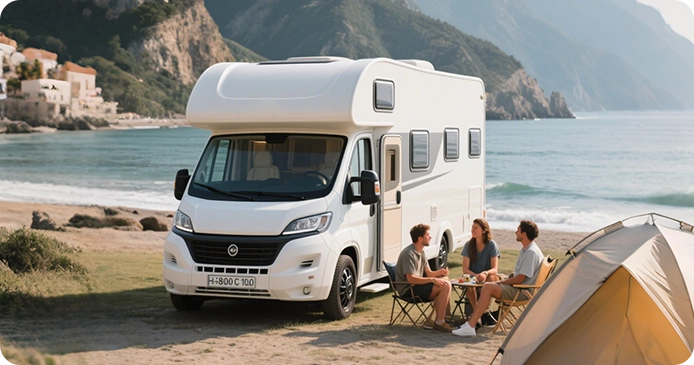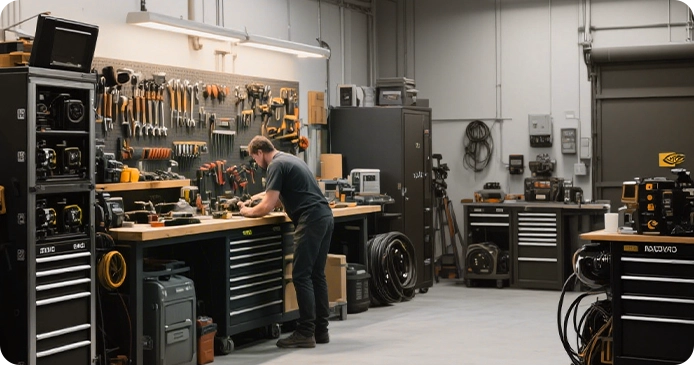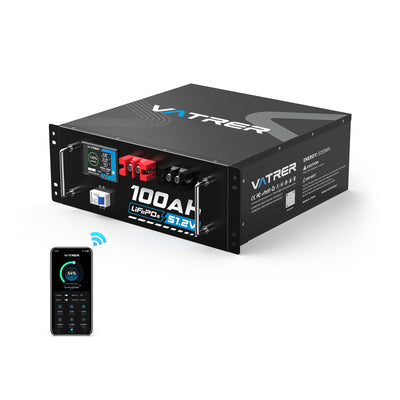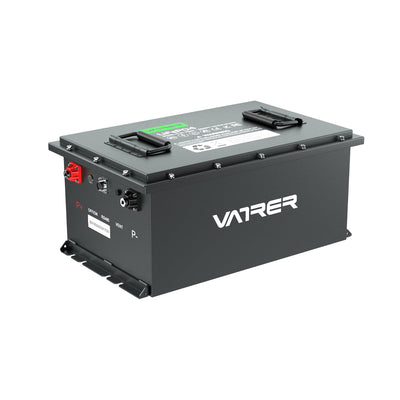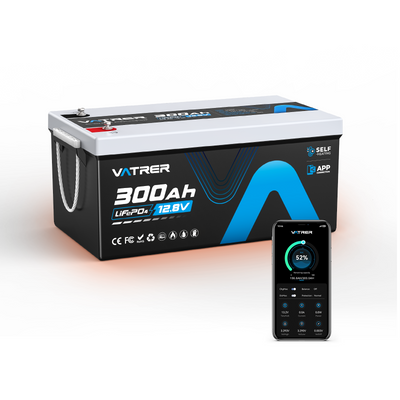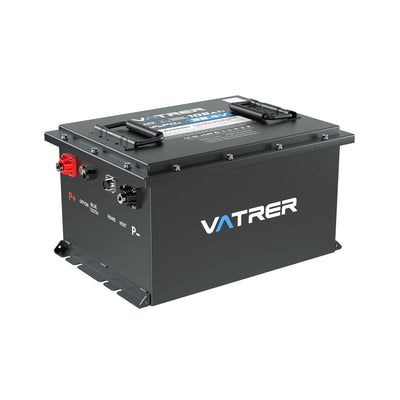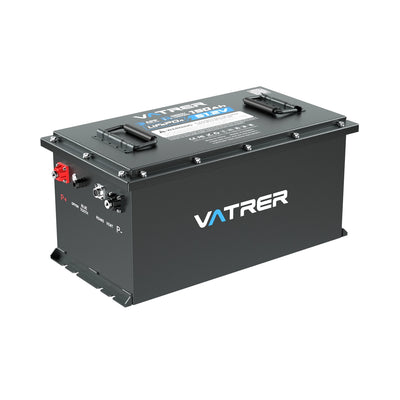
Can You Use a Deep Cycle Battery In a Car
Choosing the right battery ensures a steady supply of power for your daily commute or RV adventures. With the wide variety of batteries available today, you might wonder if a deep-cycle battery for a trolling motor or solar system could replace the standard car battery in your vehicle.
In this article, we'll delve into the differences between starting batteries and deep-cycle batteries, assess their compatibility with your vehicle's electrical system, and provide clear guidance to help you choose the best battery solution for your needs!

Understanding Car Batteries and Their Functions
A car battery is the heart of your vehicle's electrical system, powering everything from engine starts to onboard electronics. Understanding its role and the available options is key to making an informed decision.
What Does a Car Battery Do?
A car battery serves two critical functions. First, it delivers bursts of power to start the engine, providing a high-energy surge measured in cold cranking amps (CCA). This is especially vital in cold weather, where engines require more power to turn over. Second, it supplies steady electricity to accessories like headlights, radios, and USB chargers when the engine is off. The reserve capacity (RC) indicates how long the battery can run these components if the alternator fails, ensuring your vehicle remains functional.
Types of Car Batteries
Several battery types are designed for automotive use, each with unique characteristics:
- Lead-Acid Batteries: The most common and cost-effective automotive batteries, these use lead plates submerged in an acid electrolyte. They're reliable but require maintenance, such as refilling distilled water, and must be recycled properly due to hazardous materials.
- Absorbent Glass Mat (AGM) Batteries: An advanced version of lead-acid batteries, AGM batteries absorb the electrolyte in glass mats, making them spill-proof and maintenance-free. They offer a longer lifespan and flexible mounting options, ideal for vehicles with varied power needs.
- Lithium-Ion Batteries: Gaining popularity in modern vehicles, lithium batteries are lightweight, charge quickly, and maintain power longer than lead-acid batteries. Though pricier, their efficiency makes them a top choice for electric vehicles, hybrids, and performance cars.
Key Performance Metrics for Car Batteries
Choosing the right car battery depends on understanding its performance capabilities:
| Metric | Description | Why It Matters |
|---|---|---|
| Cranking Amps (CA) | Measures the battery's ability to start the engine in moderate temperatures. | Ensures reliable starts in typical conditions. |
| Cold Cranking Amps (CCA) | Indicates starting power in freezing temperatures (0° F). | Critical for cold climates where engines resist starting. |
| Reserve Capacity (RC) | Shows how long the battery can power accessories without alternator support. | Vital for vehicles with high electrical demands, like overlanding setups. |
These metrics ensure your battery delivers the power to start your vehicle and supports its electrical system effectively.
Deep Cycle Batteries vs. Car Batteries: Key Differences
To understand whether a deep-cycle battery can work in a car, it's essential to know how it differs from a standard car battery. While both power electrical systems, their designs, purposes, and performance characteristics are tailored for distinct applications. Below, we compare deep cycle batteries and car batteries, highlighting their unique features and why these differences matter for your vehicle's electrical system.
Design and Purpose
Car Batteries: Also known as starting batteries, these are engineered to deliver quick bursts of power to start a car's engine. They provide a high-energy surge, measured in cold cranking amps (CCA), to turn over the engine, especially in cold conditions.
After starting, the alternator takes over, and the battery supports minimal accessory loads (lights, radios) when the engine is off.
Car batteries use thinner lead plates to maximize surface area for rapid energy release, but they're not built for deep discharge, as draining beyond 20% can cause permanent damage.
Deep Cycle Batteries: Designed for steady, low to medium current over long periods, deep cycle batteries excel in applications requiring consistent power. They can handle deep discharge up to 80%-100% of their capacity without damage, thanks to thicker lead plates or advanced lithium-ion designs. Unlike car batteries, they're not optimized for the power to start an engine but for sustained energy output, making them ideal for non-automotive uses like trolling motors or off-grid systems and electric vehicles.
Lithium-Ion Deep Cycle Battery Benefits
While traditional deep cycle batteries are often lead-acid, lithium-ion variants, such as LiFePO4, offer significant advantages over both lead-acid deep cycle and car batteries:
- Cycle Life: Lithium-ion deep cycle batteries provide 2,000-5,000 cycles, compared to 300-500 for lead-acid deep cycle batteries and 200-400 for car batteries, ensuring long-term durability.
- Weight: Up to 50% lighter than lead-acid batteries, lithium-ion models reduce vehicle weight, improving efficiency for specialized applications.
- Thermal Stability: Unlike lead-acid deep cycle batteries, which are sensitive to high temperatures, lithium-ion versions perform well in hot environments, such as car engine compartments.
- Safety: Equipped with a Battery Management System (BMS), lithium-ion batteries prevent overcharging, overheating, and short-circuiting, offering safer operation than traditional automotive batteries.
These characteristics make lithium-ion deep-cycle batteries an ideal choice for users seeking an electric vehicle power solution, although their higher cost and specific charging requirements require careful consideration.
Application Of Deep Cycle Batteries And Automotive Batteries
Car Batteries: Primarily used in vehicles like sedans, trucks, and SUVs, car batteries are tailored for starting engines and supporting short-term accessory loads. They're found in standard automotive settings where the alternator handles most electrical demands after startup.
Deep Cycle Batteries: These shine in scenarios requiring sustained power, such as:
- Trolling motors on fishing boats for steady propulsion.
- RVs and camper trailers, powering lights, appliances, and electronics during off-grid trips.
- Golf carts, providing reliable energy for extended mobility.
- Off-grid solar or wind systems, storing energy for consistent output.
These applications highlight why deep-cycle batteries are not typically designed for the high-power demands of starting a car engine.
Key Characteristics Compared of Deep Cycle Batteries and Car Batteries
The following features underscore the differences between deep-cycle batteries and car batteries:
Plate Design
- Car Batteries: Thin lead plates maximize rapid energy release but are prone to damage from deep discharge.
- Deep Cycle Batteries: Thicker plates (in lead-acid models) or advanced lithium-ion designs withstand frequent discharge and recharging, ensuring durability.
Discharge Capability
- Car Batteries: Limited to shallow discharges (10-20%) to avoid damage, making them unsuitable for prolonged power needs.
- Deep Cycle Batteries: Can discharge up to 80% without harm, ideal for long-term power applications.
Lifespan
- Car Batteries: Typically last 2-3 years due to their focus on short bursts and limited cycling.
- Deep Cycle Batteries: Last 3-5 years (lead-acid) or up to 8-10 years (lithium-ion) with proper care, thanks to their robust design.
Temperature Performance
- Car Batteries: Perform well in moderate conditions but may struggle in extreme cold (low cold cranking amps CCA) or heat.
- Deep Cycle Batteries: Lead-acid versions are heat-sensitive, risking reduced lifespan in hot engine compartments. Lithium-ion models offer superior thermal stability, making them more versatile for automotive use.
Why It's Important To Understand The Difference Between Deep Cycle Batteries And Car Batteries
Using the wrong battery, like a deep-cycle battery in place of a car battery, can lead to performance issues. A car battery lacks the durability for long periods of power delivery, draining quickly in deep-cycle applications like golf carts or RVs. Conversely, a deep-cycle battery may struggle to provide the cold cranking amps (CCA) needed to start a car, especially in cold weather. Understanding these differences helps you avoid damaging your vehicle's electrical system and ensures you choose the right battery type for your needs.
Can a Deep Cycle Battery Power Your Car?
While technically feasible, several factors determine whether it's a practical choice.
Compatibility Requirements
Using a deep-cycle battery in a car requires meeting specific criteria.
- Voltage: Most cars use a 12-volt electrical system. A deep-cycle battery with a different voltage could damage components or cause system failures.
- Cranking Amps: Deep-cycle batteries typically have lower cold cranking amps (CCA) than starting batteries, which may struggle to provide the power to start an engine, especially in cold or low-charge conditions.
- Physical Fit: The battery must fit securely in the car's battery tray, with terminals aligned for proper connections. Mismatched sizes or terminal configurations can lead to installation issues.
Choosing the wrong battery that fails these requirements risks unreliable starts or electrical damage.
Using Deep Cycle Batteries For Vehicle Auxiliary Power
In certain scenarios, a deep-cycle battery can be practical for automotive applications:
- Overlanding and Car Camping: Vehicles modified for off-road trips often include auxiliary power systems for fridges, lights, or winches. A lithium-ion deep cycle battery can provide steady power for long periods, enhancing off-grid capabilities.
- Emergency and Utility Vehicles: Ambulances, fire trucks, or utility vehicles with high accessory demands (medical equipment, radios) may benefit from a deep-cycle battery as a secondary power source.
- Modified Vehicles: Cars with aftermarket upgrades, such as high-powered audio systems or auxiliary lighting, can use a deep-cycle battery alongside a starting battery to handle increased electrical loads.
These use cases are most effective with lithium-ion deep cycle batteries, which offer better performance and compatibility than lead-acid options.
Advantages of Using a Deep Cycle Battery in a Car
- Reliable Accessory Power: They excel at powering electronics like coolers, chargers, or camping gear for long periods without draining, ideal for overlanding or remote travel.
- Performance in Extreme Conditions: Lithium-ion deep cycle batteries handle extreme temperatures better than lead-acid batteries, ensuring reliability in hot or cold climates.
Disadvantages and Risks of Using Deep Cycle Batteries in Cars
- Limited Starting Power: Lower cold cranking amps (CCA) can lead to unreliable engine starts, especially in cold weather or when the battery is partially discharged.
- Heat Sensitivity for Lead-Acid: Lead-acid deep cycle batteries may degrade in hot engine compartments, reducing lifespan. Lithium-ion models mitigate this but require compatibility checks.
- Electrical System Mismatch: Car alternators are designed for starting batteries, and improper charging can damage a deep-cycle battery or reduce its efficiency.
- Warranty Concerns: Using a non-standard battery may void parts of your vehicle's warranty, as automakers specify approved battery types.
Finding the Right Car Battery for Your Needs
For most drivers, a standard car battery is the best choice for daily driving. These battery types are designed to deliver reliable power to start your engine and support basic accessories. However, for vehicles with specialized needs, such as overlanding, car camping, or emergency services, a deep-cycle battery may be a viable option if compatibility is ensured.
Vatrer deep-cycle batteries, like the Vatrer, offer a versatile solution specifically for deep-cycle applications like electric vehicles. These batteries boast a cycle life of 2,000-5,000 cycles and feature smart Bluetooth monitoring for real-time performance tracking via a mobile app. Their lightweight design and thermal stability make them ideal for high-demand applications, such as powering auxiliary systems in modified vehicles. Before replacing a deep-cycle battery, always consult your vehicle manual or a qualified technician to confirm compatibility with your electrical system.
Conclusion
While a deep-cycle battery can technically power a car, it's not the best fit for most drivers. For standard driving, a lead-acid, AGM, or lithium-ion car battery is typically the most reliable and cost-effective choice. For specialized applications like overlanding or emergency vehicles, a lithium-ion deep cycle battery may be suitable, provided you address compatibility and charging needs.
To discover high-quality lithium batteries tailored to your vehicle's needs, explore Vatrer LiFePO4 battery.
Share
1 comment
Excellent insights on deep cycle vs. car batteries. Clear, informative, and practical great resource for vehicle power decisions




























